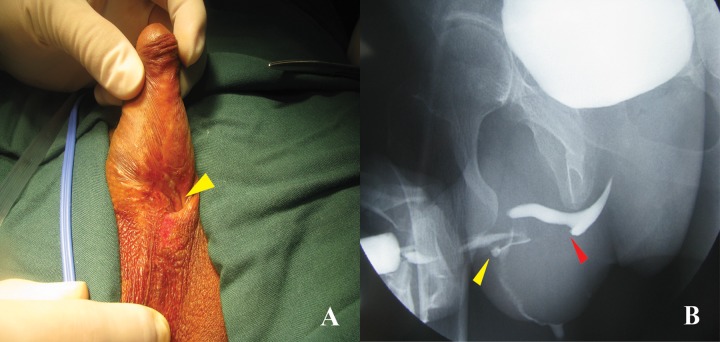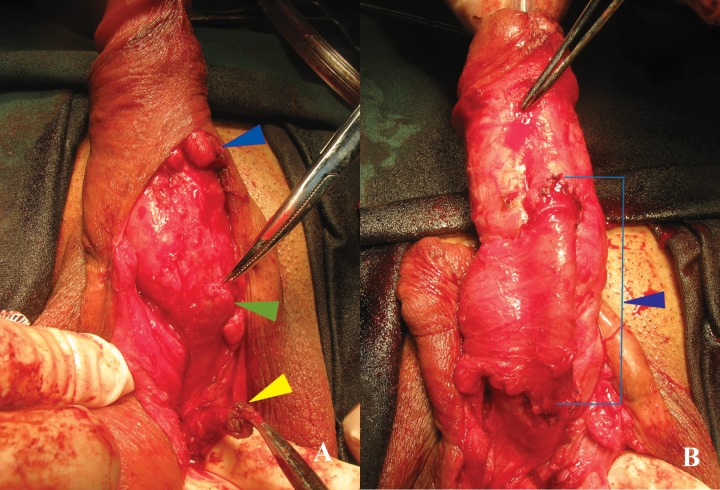Abstract
Patient: Male, 24
Final Diagnosis: Urethral stricture
Symptoms: —
Medication: —
Clinical Procedure: —
Specialty: Urology
Objective:
Unusual or unexpected effect of treatment
Background:
The most dependable management of anterior urethral stricture is the complete excision of the area of fibrosis, with a primary reanastomosis of the normal ends of the anterior urethra.
Case Report:
A 24-year-old man had urethral stricture in the penoscrotal junction caused by catheterization approximately 3 years ago. After the resection of the urethral stricture segment and the end-to-end anastomosis were performed, in addition to stricture, urethrocutaneous fistula formation as another complication in the penoscrotal junction was confirmed. The direct vision internal urethrotomy did not improve all the above symptoms. The retrograde urethrogram and voiding cysto-urethrogram showed complete obliteration in the penile urethra, urethrocutaneous fistula, and proximal urethral bifurcation singularity. Intraoperatively, we found that the distal urethral end had been anastomosed to the proximal false passage in the initial surgery and the proximal urethra was located in the dorsal side of the false passage. Then, tubularized preputial flap urethroplasty was performed. The patient was followed up for 10 months. His peak urinary flow was 18.3 milliliter per second.
Conclusions:
We would remind urologists that urethral end intraoperatively anastomosed to the false passage is a rare, serious, avoidable, and elementary medical error. Urethroplasty is one of the curative choices for treatment of this unexpected condition.
MeSH eywords: Urethra – surgery, Urethroplasty, False passage, Urethral Stricture – surgery, Urinary Fistula – surgery
Background
Urethral stricture is one of the oldest known urological diseases. Urethral stricture mainly involves the anterior urethra. The etiology of anterior urethral strictures varies from iatrogenic causes to infection and inflammatory, blunt pelvic trauma, lichen sclerosus, and unknown causes. In the past, anterior urethral strictures due to infective or inflammatory causes, such as secondary to gonococcal urethritis, predominated. With the development of antibiotics, there is now a changing pattern of etiology. Fenton et al. [1] reported that idiopathic (34%) or iatrogenic (32%) causes accounted for the majority of symptomatic anterior urethral strictures, following by inflammatory (20%) or traumatic (14%) causes. In developed countries, about 16.3% of iatrogenic urethral stricture comes from catheterization [2].
Treatment of urethral stricture includes intermittent urethral dilation or self-catheterization, internal urethrotomy, urethral stent placement, and urethroplasty. Unfortunately, repeat urethral dilation and internal urethrotomy for the treatment of urethral stricture are neither clinically effective nor cost-effective [3]. Moreover, repeated internal urethrotomy could worsen the stricture [4,5]. There is no doubt that open reconstruction or urethroplasty is the optimal choice of management for urethral strictures, especially for strictures greater than 1 centimeter in length.
Here, we report a rare case of reconstruction for the distal urethral end incorrectly anastomosed to the proximal false passage in the treatment of urethral stricture. This condition has not previously been reported in the literature. The patient’s informed consent was obtained prior to the writing of this article.
Case Report
A 24-year-old man underwent an operation for traumatic fracture of the right lower limb under general anesthesia with catheter in another hospital approximately 3 years ago. The urinary catheter was removed on postoperative day 3. Two weeks later, he complained of dysuria. After confirmation of urethral stricture, resection of the urethral stricture segment and end-to-end anastomosis were performed. Unfortunately, the urethrocutaneous fistula formation in the anastomosis site, dysuria, and penile chordee were found after postoperative catheter removal. About 1 year ago, direct vision internal urethrotomy was performed in the same hospital. However, the urethrocutaneous fistula in the penoscrotal junction and dysuria re-emerged after catheter removal (Figure 1A). After repeated urethral dilatation, the symptoms did not improve. He was admitted to our department after suprapubic cystotomy for urethral stricture and fistula formation.
Figure 1.
(A) The yellow arrow shows urethrocutaneous fistula formation in the penoscrotal junction. (B) The urethrocutaneous fistula (yellow arrow) and proximal urethral bifurcation singularity (red arrow) in the retrograde urethrogram and voiding cysto-urethrogram.
Relevant hematological and biochemical investigations including urine cultures were normal, but routine urinalysis showed that the red-cell and white-cell counts were 6 and 87 per high-power field, respectively. The retrograde urethrogram and voiding cysto-urethrogram showed complete obliteration in the penile urethra, urethrocutaneous fistula, and proximal urethral bifurcation singularity (Figure 1B).
Preoperative preparation included oral moxifloxacin at 400 mg daily and external genital area cleaning 4–6 times a day with 1: 1000 benzalkonium chloride for 3 days. Intraoperatively, we found that the distal urethral end was anastomosed to the proximal false passage in an initial surgery and the proximal urethra was located in the dorsal side of the false passage.
The urethral defect was found to be 4 centimeters after dissection of both ends of the urethra and resection of stricture segments in penile straight condition (Figure 2A).
Figure 2.
(A) The yellow arrow shows the urethrocutaneous fistula and false passage, and the green and blue arrows show the proximal and distal urethra, respectively. (B) The blue arrow shows the tubularized preputial flap was anastomosed tension-free to distal and proximal urethras.
Similar to Duckett’s procedure for hypospadias [6], transverse pedunculated preputial flap was harvested and tubularized to produce a urethral lumen approximately 4 cm in length and 26-Fr in diameter. An 18-Fr 100% silicone catheter is used as a stent. Subsequently, the tubularized preputial flap was anastomosed tension-free to distal and proximal urethras followed by second-layer coverage using subcutaneous tissue (Figure 2B). The surgical wound was dressed on the seventh post-operative day and the catheter was removed on the twenty-first day.
The patient was followed up for 10 months. He had been free of the catheter, with 18.3 milliliter per second peak urinary flow. There were no the other postoperative complications such as infection, recurrence of urethral stricture and fistula, cutaneous necrosis, incontinence, or erectile dysfunction.
Discussion
Urethral dilation, as the oldest and simplest treatment of urethral stricture, may be only curative for the patient with an epithelial stricture without spongiofibrosis. Internal urethrotomy can be effective for the patient with very short urethral strictures that do not involve the membranous urethra. Recurrence is the most common complication of internal urethrotomy. The recurrence rate of stricture was reported as 19.4% in a series of patients treated by urethrotomy [7].
In this case, the urethral stricture was obviously iatrogenic, caused by urethral catheter use. Although the patient underwent resection of the stricture segment and end-to-end anastomosis followed by direct vision internal urethrotomy and dilatation, his obstructive voiding symptoms and subsequent urethrocutaneous fistula did not improve. Until the exploratory operation, the proximal urethral bifurcation singularity in the retrograde urethrogram and voiding cysto-urethrogram was thought to be a false passage. A urethral end intraoperatively anastomosed to the false passage is a rare and serious medical mistake. Until re-operation, the formation of urethrocutaneous fistula and unimproved voiding symptoms after direct vision internal urethrotomy in this case is understandable.
Repeated internal urethrotomy will not only delay cure, but may also worsen stricture characteristics by increasing the length of the stricture and causing more spongiofibrosis [4,5]. The most dependable technique of anterior urethral reconstruction is the complete excision of the area of fibrosis, with a primary reanastomosis of the normal ends of the anterior urethra. Therefore, in this case, tubularized preputial flap urethroplasty is one of the curative choices for treatment of this unexpected condition. Unfortunately, due to delays in referral to a specialist who performs urethroplasty and because of a shortage of excellent centers in urethral reconstruction, internal urethrotomy has been over-used and urethroplasty under-used [5].
Conclusions
Acquired urethral stricture or fistula is quite unexpected and may result in much inconvenience, discomfort, physical disability, and psychological distress for the affected individual. We would remind urologists that urethral end intraoperatively anastomosed to the false passage is a rare, serious, avoidable, and elementary medical error. Urethroplasty is one of the curative choices for treatment of this unexpected condition.
Footnotes
Conflict of interest
The authors have no conflicts of interest regarding this article.
References:
- 1.Fenton AS, Morey AF, Aviles R, Garcia CR. Anterior urethral strictures: etiology and characteristics. Urology. 2005;65:1055–58. doi: 10.1016/j.urology.2004.12.018. [DOI] [PubMed] [Google Scholar]
- 2.Palminteri E, Berdondini E, Verze P, et al. Contemporary urethral stricture characteristics in the developed world. Urology. 2013;81:191–96. doi: 10.1016/j.urology.2012.08.062. [DOI] [PubMed] [Google Scholar]
- 3.Greenwell TJ, Castle C, Andrich DE, et al. Repeat urethrotomy and dilation for the treatment of urethral stricture are neither clinically effective nor cost-effective. J Urol. 2004;172:275–77. doi: 10.1097/01.ju.0000132156.76403.8f. [DOI] [PubMed] [Google Scholar]
- 4.Roehrborn CG, McConnell JD. Analysis of factors contributing to success or failure of 1-stage urethroplasty for urethral stricture disease. J Urol. 1994;151:869–74. doi: 10.1016/s0022-5347(17)35109-1. [DOI] [PubMed] [Google Scholar]
- 5.Anger JT, Buckley JC, Santucci RA, et al. Trends in stricture management among male Medicare beneficiaries: underuse of urethroplasty. Urology. 2011;77:481–85. doi: 10.1016/j.urology.2010.05.055. [DOI] [PMC free article] [PubMed] [Google Scholar]
- 6.Duckett JW., Jr Transverse preputial island flap technique for repair of severe hypospadias. Urol Clin North Am. 1980;7:423–30. [PubMed] [Google Scholar]
- 7.Hradec E, Jarolim L, Petrik R. Optical internal urethrotomy for strictures of the male urethra. Effect of local steroid injection. Eur Urol. 1981;7:165–68. doi: 10.1159/000473209. [DOI] [PubMed] [Google Scholar]




